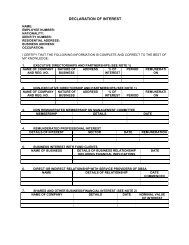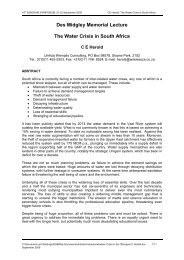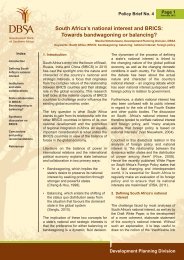A Knowledge Strategy
A Knowledge Strategy
A Knowledge Strategy
Create successful ePaper yourself
Turn your PDF publications into a flip-book with our unique Google optimized e-Paper software.
number of ‘silo’ information systems and resultant multiple data sources from the<br />
point of view of enterprise business processes. The culmination of this effort is that<br />
we are now presented with the opportunity to create a single data repository<br />
containing initially all the transactional data to help drive and capacitate<br />
management information and decisions.<br />
Bank staff, their, skills, experience and knowledge represent the Bank’s ‘stock in<br />
trade’. Through the collective efforts of its individual employees the Bank conducts<br />
business. <strong>Knowledge</strong>able and well-informed staff make a greater contribution to<br />
building business processes and systems that in turn support staff in the execution<br />
of their tasks. At the same time comprehensive records retain the history of these<br />
tasks addressing the problem of poor knowledge retention and encouraging a<br />
culture of sharing information that is critical for the effective long-term<br />
sustainability of any knowledge management or information technology initiative.<br />
As an organisation grows and becomes more complex, management makes<br />
greater demands on the internal information systems. Information is a key<br />
ingredient in any decision-making process and at all levels – strategic, operational<br />
or tactical. Research shows that executives are faced with major challenges with<br />
regard to information in achieving their objectives. In response to surveys<br />
interrogating information requirements, executives identify the same five<br />
requirements, that:<br />
• access to data or information should be in a useful format - as and when needed;<br />
• information systems should be agile and adaptable to changing business needs<br />
and regulatory environments;<br />
• information or data should be accurate and consistent;<br />
• that same information or data must be shared across the organisation; and<br />
• information or data must be provided at a reasonable, but affordable cost.<br />
These requirements constitute the mission or business imperative of the ICT function<br />
in any organisation. Provide quality data to those who need it. For ICT strategy, the<br />
emphasis is invariably on the word ‘data’, not ‘information’. Peter Drucker describes<br />
information as ‘data endowed with relevance and purpose’. Unlike data, information<br />
has meaning or value which is derived by transforming the data in various ways<br />
(categorised, summarised, corrected or calculated). This is clearly beyond the scope of<br />
the ICT mandate and in the realm of information and knowledge management. From<br />
a technical point of view, the ICT function in the Bank is the custodian of data assets.<br />
<strong>Knowledge</strong> workers are the custodians of the information resources.<br />
Enterprise architecture<br />
In 1987, John A Zachman published a paper in the IBM Systems Journal that is<br />
considered seminal in defining the concepts and relationships of information<br />
systems architecture. It identified a framework of six levels of architecture<br />
beginning with the conceptual levels of the ‘planners view’ through to the<br />
functioning enterprise or systems level. Zachman explains his framework for<br />
information system architecture in terms of an analogy with the process of<br />
planning, drafting and building a new home. Increasing levels of detail appropriate<br />
44 Development Bank of Southern Africa

















